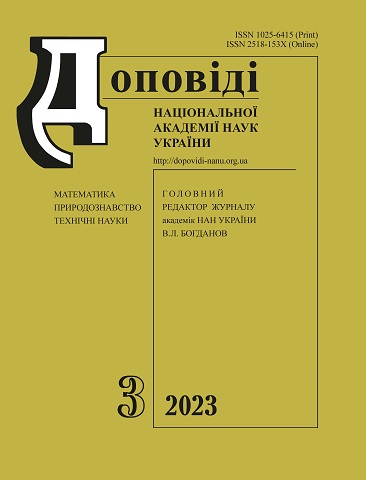Деформаційні ефекти у кристалах германію діркової провідності
DOI:
https://doi.org/10.15407/dopovidi2023.03.031Ключові слова:
германій, діркова провідність, гальваномагнітні ефекти, деформаційні ефектиАнотація
На монокристалах p-Ge з питомим опором ρ300K ≈ 16 Ом·см одержано при 300 і 77 K польові залежності коефіцієнта Холла за умов || || [100] і || || [111] (магнітне поле спрямоване вздовж напрямку [10], — струм крізь зразок) за різних значень тиску . На зразках обох кристалографічних орієнтацій при 77 K (за відсутності та за наявності тиску) виявлено тонку структуру польових залежностей коефіцієнта Холла, пов’язану з анізотропією зони важких дірок. Виявлено істотне згладжування тонкої структури зі збільшенням тиску. Показано якісно різну поведінку коефіцієнта Холла з тиском у слабких і більш сильних магнітних полях. Одержано залежності питомого опору та поздовжнього магнітоопору з тиском, виміряні за температури рідкого азоту на тих самих зразках двох кристалографічних орієнтацій. Виявлено чітко виражену анізотропію тензоопору і тензо-холл-ефекту як за відсутності, так і за наявності тиску. Встановлено, що основна перебудова деформованої сфери важких дірок вихідного кристала в еліпсоїди відбувається (у зразках обох орієнтацій) в інтервалі X ≤ 0,6÷0,7 ГПа, а в разі подальшого збільшення тиску параметри еліпсоїдів, що утворилися, змінюються відносно слабко. Виявлено у зразках обох кристалографічних орієнтацій відмінність від нуля поздовжнього магнітоопору , а також різко виражену його анізотропію, яка не зникає до найбільших тисків, досягнутих в експерименті. Показано тенденцію до зростання поздовжнього магнітоопору зі збільшенням тиску за умов || || [100] і 77 K.
Завантаження
Посилання
Baranskii, P. I., Belyaev, A. E. & Gaidar, G. P. (2019). Kinetic effects in multi-valley semiconductors. Kyiv: Naukova Dumka (in Ukrainian).
Claeys, C. & Simoen, E. (2007). Germanium-based technologies: From materials to devices. 1 ed. Elsevier Science Publishing Company.
Oksanych, A. P. & Malovanyi, V. V. (2013). Development of technique and device for research of optical quality of germanium single crystal. Visnyk Kremenchutskoho natsionalnoho universytetu imeni Mykhaila Ostrohradskoho, No. 1(78), pp. 18-22 (in Ukrainian). http://www.kdu.edu.ua/statti/2013-1(78)/18.pdf
Chen, J., Zhang, X., Luo, Z., Wang, J. & Piao, H.-G. (2014). Large positive magnetoresistance in germanium. J. Appl. Phys., 116, No. 11, pp. 114511. https://doi.org/10.1063/1.4896173
Volodin, V. A., Kamaev, G. N., Gritsenko, V. A., Gismatulin, A. A., Chin, A. & Vergnat, M. (2019). Memristor ef-fect in GeO[SiO2] and GeO[SiO] solid alloys films. Appl. Phys. Lett., 114, No. 23, pp. 233104. https://doi.org/10.1063/1.5079690
Astankova, K. N., Volodin, V. A. & Azarov, I. A. (2020). Structure of germanium monoxide thin films. Semi-conductors, 54, No. 12, pp. 1555-1560. https://doi.org/10.1134/S1063782620120027
Saito, S., Al-Attili, A. Z., Oda, K. & Ishikawa, Y. (2016). Towards monolithic integration of germanium light sources on silicon chips. Semicond. Sci. Technol., 31, No. 4, pp. 43002 (19). https://doi.org/10.1088/0268-1242/31/4/043002
Baldassarre, L., Sakat, E., Frigerio, J., Samarelli, A., Gallacher, K., Calandrini, E., Isella, G., Paul, D.J., Ortolani, M. & Biagioni, P. (2015). Midinfrared Plasmon-Enhanced Spectroscopy with Germanium Antennas on Silicon Substrates. Nano Lett., 15, No. 11, pp. 7225-7231. https://doi.org/10.1021/acs.nanolett.5b03247
Boucaud, P., Kurdi, M. El, Ghrib, A., Prost, M., de Kersauson, M., Sauvage, S., Aniel, F., Checoury, X., Beaudoin, G., Largeau, L., Sagnes, I., Ndong, G., Chaigneau, M. & Ossikovski, R. (2013). Recent advances in germanium emission. Photonics Research, 1, No. 3, pp. 102-109. https://doi.org/10.1364/PRJ.1.000102
Konle, J., Presting, H., Kibbel, H. & Banhart, F. (2002). Growth studies of Ge-islands for enhanced perfor-mance of thin film solar cells. Mater. Sci. Eng. B, 89, No. 1-3, pp. 160-165. https://doi.org/10.1016/S0921-5107(01)00824-8
Baranskii, P. I., Fedosov, А. V. & Gaidar, G. P. (2000). Physical properties of silicon and germanium crystals in the fields of effective external influence. Lutsk: Nadstyr’ya (in Ukrainian).
Patel, N. S., Monmeyran, C., Agarwal, A. & Kimerling, L. C. (2015). Point defect states in Sb doped germanium. J. Appl. Phys., 118, No. 15, pp. 155702. https://doi.org/10.1063/1.4933384
Bir, G. L. & Pikus, G. E. (1972). Symmetry and deformation effects in semiconductors. Moscow: Nauka (in Russian). https://ikfia.ysn.ru/wp-content/uploads/2018/01/BirPikus1972ru.pdf
Baranskii, P. I., Buda, I. S., Dakhovskii, I. V. & Kolomoets, V. V. (1977). Electrical and galvanomagnetic phe-nomena in anisotropic semiconductors. Kyiv: Naukova Dumka (in Russian).
Gaidar, G. P. (2016). Magneto- and tensoresistance of the p-Ge compensated crystals in the range of weak, intermediate and classically strong magnetic fields. Physics and Chemistry of Solid State, 17, No. 1, pp. 43-47. https://doi.org/10.15330/pcss.17.1.43-47
##submission.downloads##
Опубліковано
Як цитувати
Номер
Розділ
Ліцензія
Авторське право (c) 2023 Доповіді Національної академії наук України

Ця робота ліцензується відповідно до Creative Commons Attribution-NonCommercial 4.0 International License.




